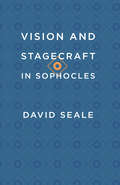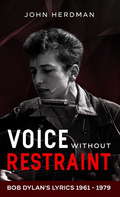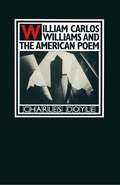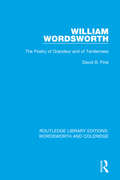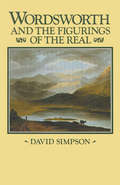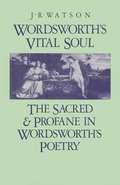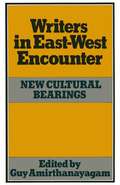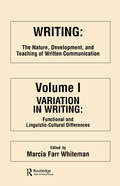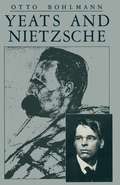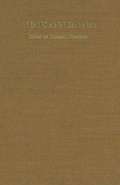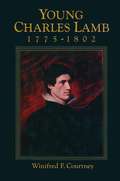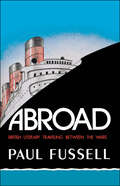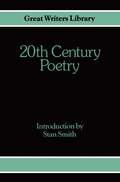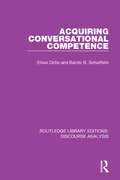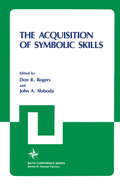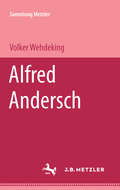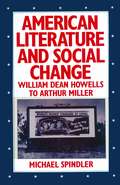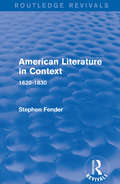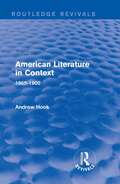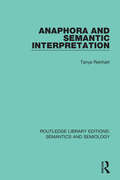- Table View
- List View
Vision and Stagecraft in Sophocles
by David SealeIn this study, David Seale argues that Sophocles’s use of stagecraft, which has thus far received little attention, was as sophisticated as that of Aeschylus or Euripides. His discussions of the physical and visual elements of Sophocles's seven plays center around the theme of sight; he demonstrates that each play is staged to maximize the implications and effects of “seeing” and not “seeing,” of knowledge and ignorance. This emphasis on visual perception, Seale maintains, harmonizes with Sophocles’s use of verbal and thematic techniques to create dramatic movements from delusion to truth, culminating in climaxes that are revelations—moments when things are truly “seen” by both audience and characters.
Voice Without Restraint: Bob Dylan's Lyrics 1961 - 1979
by John HerdmanBob Dylan was awarded the Nobel Prize in Literature in June 2016, and seldom in recent years has it been more richly deserved.That a song writer’s lyrics should be regarded as literature was an idea at which many were surprised.Others have felt that to isolate the lyrics of a song from its musical context is unreal. Ultimately that is true: a song is an indefeasible whole, an inseparable marriage of words and music which achieves its overall emotional effect by that symbiosis and not otherwise.Yet it can also be said that the two components can be separately considered as two elements in the artist’s creative utterance, and discussed as such.The evidence of Dylan’s manuscripts supports the view that in writing his lyrics his way of going about things is not always widely different from that of a poet.Bob Dylan commented on the Nobel Prize in Literature which was awarded to him "for having created new poetic expressions within the great American song tradition": "When I first received this Nobel Prize for Literature, I got to wondering exactly how my songs related to literature. I wanted to reflect on it and see where the connection was."Voice Without Restraint, refers to and is from the song “I dreamed I saw St Augustine” on John Wesley Harding, and is a phrase chosen to evoke the full-blooded commitment to his artistic utterance which is the hallmark of Bob Dylan’s voice – in all senses.
William Wordsworth: The Poetry of Grandeur and of Tenderness (RLE: Wordsworth and Coleridge)
by David B. PirieFirst published in 1982. In this study of Wordsworth’s major poetry, the author explores the conflict between the poet’s celebration of an impersonal earth and his concern for the most intensely personal relationships. The opening chapter concentrates on Wordsworth’s struggle to describe the natural world and the extraordinary claims he makes for the natural landscape — which are shown to derive not from vague mysticism but precisely articulated common sense. The close readings of Michael, The Idiot Boy, Tintern Abbey and The Ruined Cottage, and poems as passages on solitaries are supported by generous quotations and discussion of other critical views.
William Wordsworth: The Poetry of Grandeur and of Tenderness (RLE: Wordsworth and Coleridge)
by David B. PirieFirst published in 1982. In this study of Wordsworth’s major poetry, the author explores the conflict between the poet’s celebration of an impersonal earth and his concern for the most intensely personal relationships. The opening chapter concentrates on Wordsworth’s struggle to describe the natural world and the extraordinary claims he makes for the natural landscape — which are shown to derive not from vague mysticism but precisely articulated common sense. The close readings of Michael, The Idiot Boy, Tintern Abbey and The Ruined Cottage, and poems as passages on solitaries are supported by generous quotations and discussion of other critical views.
Wordsworth and the Figurings of the Real
by David SimpsonPerhaps the most powerful feature of the Romantic imagination is its ability to dissolve existing form and order and create it anew. The Romantic investigation of the functions of the imagination also leads to important insights concerning its problems and dangers. Because it separates the person experiencing it from others around him, the imagination introduces ways of seeing which cannot be assumed to be simply communicable or easily shared, and which have as their objects different forms or 'things'. These forms, or figures, risk becoming for their originators both vehicles of power, in so far as they do convince others of their reality, and limiting constructs of prefigured order, inhibiting their users from the perception of new relations and alternative meanings. When the figured becomes the real, there thus arise difficulties in both individual and social perceptions. Arguing from the stance that all perception takes place by a creative (and hence potentially divisive) assembly of images or qualities into things, David Simpson shows that the analysis of figurative representation in Wordsworth's writing is of central importance to his idea of the human mind, and the way in which it is affected or allowed to function by its environment, both human and physical. In this way Wordsworth's ideas about the function of literature in society are seen to be more fully worked out than readers have often assumed them to be. Simpson pays particular attention to the ethical consequences of different ways of figuring the real, offering an explanation of Wordsworth's distinction between life in the town and life among the mountains and lakes of north-west England. In relating Wordsworth's poetry to important contemporary debates in political economy such as those concerning the division of labour and the evaluation of the advantages and disadvantages of commerce and luxury, he suggests that Wordsworth is a notable precursor of that nineteenth-century tradition which sees the mind as open to critical determination by social and environmental factors.
Writing: The Nature, Development, and Teaching of Written Communication
by M. Farr WhitemanFirst Published in 1982. Routledge is an imprint of Taylor & Francis, an informa company.
Writing: The Nature, Development, and Teaching of Written Communication
by M. Farr WhitemanFirst Published in 1982. Routledge is an imprint of Taylor & Francis, an informa company.
Yeats and Nietzsche: An Exploration of Major Nietzschean Echoes in the Writings of William Butler Yeats
by Otto BohlmannYeats Annual: An Annual Of Critical And Textual Studies 1995 (Macmillan Literary Annuals #13)
by Richard J. FinneranAbroad: British Literary Traveling between the Wars
by Paul FussellA book about the meaning of travel, about how important the topic has been for writers for two and a half centuries, and about how excellent the literature of travel happened to be in England and America in the 1920s and 30s.
Acquiring conversational competence (RLE: Discourse Analysis)
by Elinor Ochs Bambi B. SchieffelinFirst published in 1983, this book represents a substantial body of detailed research on children’s language and communication, and more generally on the nature of interactive spoken discourse. It looks at areas of competence often examined in young children’s speech have that have not been described for adults — leading to insights not only in the character of adult conversation but also the process of acquiring this competence. The authors set forward strategies for conversing at different stage of life, while also relating these strategies to, and formulating hypotheses concerning, the dynamics of language variation and change.
Acquiring conversational competence (RLE: Discourse Analysis)
by Elinor Ochs Bambi B. SchieffelinFirst published in 1983, this book represents a substantial body of detailed research on children’s language and communication, and more generally on the nature of interactive spoken discourse. It looks at areas of competence often examined in young children’s speech have that have not been described for adults — leading to insights not only in the character of adult conversation but also the process of acquiring this competence. The authors set forward strategies for conversing at different stage of life, while also relating these strategies to, and formulating hypotheses concerning, the dynamics of language variation and change.
The Acquisition of Symbolic Skills (Nato Conference Series #22)
by Don Rogers John A. SlobodaThis book is a selection of papers from a conference which took place at the University of Keele in July 1982. The conference was an extraordinarily enjoyable one, and we would like to take this opportunity of thanking all participants for helping to make it so. The conference was intended to allow scholars working on different aspects of symbolic behaviour to compare findings, to look for common ground, and to identify differences between the various areas. We hope that it was successful in these aims: the assiduous reader may judge for himself. Several themes emerged during the course of the conference. Some of these were: 1. There is a distinction to be made between those symbol systems which attempt, more or less directly, to represent a state of affairs in the world (e. g. language, drawing, map and navigational skill) and those in which the representational function is complemented, if not overshadowed, by properties of the symbol system itself, and the systematic inter-relations that symbols can have to one another (e. g. music, mathematics). The distinction is not absolute, for the nature of all symbolic skills is, in part, a function of the structure of the symbolic system employed. Nonetheless, this distinction helps us to understand some common acquisition difficulties, such as that experienced in mathematics, where mental manipulation of symbols can go awry if a child assumes too close a correspondence between mathematical symbols and the world they represent. 2.
American Literature and Social Change (pdf): William Dean Howells to Arthur Miller
by Michael SpindlerAmerican Literature in Context: 1620-1830 (Routledge Revivals: American Literature in Context)
by Stephen FenderFirst published between 1982 and 1983, this series examines the peculiarly American cultural context out of which the nation’s literature has developed. Covering the years from 1620 to 1830, this first volume of American Literature in Context examines a range of texts from the writings of the Puritan settlers through the declaration of Independence to the novels of Fenimore Cooper. In doing so, it shows how early Americans thought about their growing nation, their arguments for immigration, for political and cultural independence, and the doubts they experienced in this ambitious project. This book will be of interest to those studying American literature and American studies.
American Literature in Context: 1865-1900 (Routledge Revivals: American Literature in Context)
by Andrew HookFirst published between 1982 and 1983, this series examines the peculiarly American cultural context out of which the nation’s literature has developed. Covering the years from 1865 to 1900, this third volume of American Literature in Context focuses on the struggles of American writers to make sense of their rapidly changing world. In addition to such major figures as Walt Whitman, Henry James, Emily Dickinson and Mark Twain, it analyses the writings of an unorthodox economist (Henry George), a Utopian reformer (Edward Bellamy) and a critical sociologist (Thorstein Veblen). Particular attention is paid to the challenge to conventional literary and cultural values represented by writers such as William Dean Howell who pursued a new form of scientific, democratic realism in American writing. This book will be of interest to those studying American literature and American studies.
American Literature in Context: 1865-1900 (Routledge Revivals: American Literature in Context)
by Andrew HookFirst published between 1982 and 1983, this series examines the peculiarly American cultural context out of which the nation’s literature has developed. Covering the years from 1865 to 1900, this third volume of American Literature in Context focuses on the struggles of American writers to make sense of their rapidly changing world. In addition to such major figures as Walt Whitman, Henry James, Emily Dickinson and Mark Twain, it analyses the writings of an unorthodox economist (Henry George), a Utopian reformer (Edward Bellamy) and a critical sociologist (Thorstein Veblen). Particular attention is paid to the challenge to conventional literary and cultural values represented by writers such as William Dean Howell who pursued a new form of scientific, democratic realism in American writing. This book will be of interest to those studying American literature and American studies.
American Literature in Context: 1620-1830 (Routledge Revivals: American Literature in Context)
by Stephen FenderFirst published between 1982 and 1983, this series examines the peculiarly American cultural context out of which the nation’s literature has developed. Covering the years from 1620 to 1830, this first volume of American Literature in Context examines a range of texts from the writings of the Puritan settlers through the declaration of Independence to the novels of Fenimore Cooper. In doing so, it shows how early Americans thought about their growing nation, their arguments for immigration, for political and cultural independence, and the doubts they experienced in this ambitious project. This book will be of interest to those studying American literature and American studies.
Anaphora and Semantic Interpretation (Routledge Library Editions: Semantics and Semiology)
by Tanya ReinhartFirst published in 1983, this book examines anaphora — a central issue in linguistic theory as it lies at the crossroads of several major problems. On the one hand it is believed that the same conditions that govern the interpretation of anaphora also govern syntactic movement rules but on the other, while anaphora is known to interact with various discourse and semantic considerations, it also provides a clear instance of the dependency of the semantic interpretation of sentences upon semantic properties of natural language. This book has two major goals: the first is a comprehensive analysis of sentence-level anaphora that addresses the questions posed above, and the second is an examination of the broader issues of the relations between the structural properties of sentences and their semantic interpretation within the hypotheses of the autonomy of syntax and of interpretative semantics shown by Chomsky.
